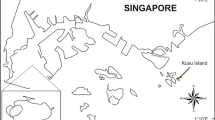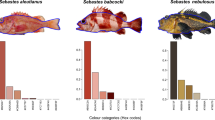Abstract
Surveys of the coral-inhabiting snailCoralliophila violacea (Lamarck) (=C. neritoidea Kiener) were made on shallow fringing reefs (<8 m deep) around Hsiao-Liuchiu, Taiwan, between July and October 1990. The snails were aggregated into patches on the surface of massive poritid coral colonies. Coral colonies >40 cm in diameter were more likely to bear patches of snails than smaller colonies, and also to have more snails. The coralliophilids ranged from 5 to 30 mm in aperture length. The sex ratio of the population was biased toward males (539:279), with only a few small individuals of indistinguishable sex. Snails between 6 and 10 mm were all males, while most snails with aperture lengths ≥20 mm were females. Judging from the distinct size ranges of males and females within patches and from the observed degeneration of the penis, the snails may have changed sex from male to female with increasing size. Sex-change may occur across a wide size range (10 to 20 mm). The correlation of smallest female size and largest male size among patches indicates that snail size at sex-change is peculiar to each individual patch. Those females in patches with a single female (but many males) were significantly smaller than females in multiple-female patches. It is likely that in the absence of females males change sex at a smaller size, whereas in the presence of large females males delay sexchange until they have reached a larger size. The plasticity of size at sex-change may be adaptive and a result of natural selection at the individual level.
Similar content being viewed by others
Literature cited
Brawley, S. H., Adey, W. H. (1982).Coralliophila abbreviata: a significant corallivore! Bull. mar. Sci. 32: 595–599
Chanov, E. L. (1982). The theory of sex allocation. Princeton University Press, Princeton, New Jersey
Chanov, E. L., Bull, J. J. (1989). Non-Fisherian sex ratios with sex change and environmental sex determination. Nature, Lond. 338: 148–150
Coe, W. R. (1953). Influences of association, isolation, and nutrition on the sexuality of snails of the genusCrepidula. J. exp. Zool. 122: 5–19
Creese, R. G., Shiel, D. R., Kingsford, M. J. (1990). Sex change in a giant endemic limpet,Patella kermadecensis, from the Kermadec Islands. Mar. Biol. 104: 419–426
Ghiselin, M. T. (1969). The evolution of hermaphroditism among animals. Q. Rev. Biol. 44: 189–208
Gould, H. N. (1952). Studies on sex in the hermaphrodite molluskCrepidula plana. 4. Internal and external factors influencing growth and sex development. J. exp. Zool. 119: 93–163
Hayes, J. A. (1989). The biology and ecology ofCoralliophila abbreviata Lamarck (Gastropoda, Coralliophilidae): the importance of corallivores in the ecology of coral reefs. Ph. D. dissertation. University of Texas at Austin
Hayes, J. A. (1990). Distribution, movement and impact of the corallivorous gastropodCoralliophila abbreviata (Lamarck) on a Panamanian patch reef. J. exp. mar. Biol. Ecol. 142: 25–42
Hoagland, K. E. (1978). Protandry and the evolution of environmentally-mediated sex change: a study of the Mollusca. Malacologia 17: 365–391
Miller, A. C. (1981). Cnidarian prey of the snailsCoralliophila abbreviata andC. caribaea (Gastropoda: Muricidae) in Discovery Bay, Jamaica. Bull. mar. Sci. 31: 932–934
Orton, J. H. (1912). An account of the natural history of the slipper limpet (Crepidula fornicata) with some remarks on its occurrence in the oyster ground on the Essex coast. J. mar. biol. Ass. U.K. 9: 437–478
Ott, B. S., Lewis, J. B. (1972). The importance of the gastropod,Coralliophila abbreviata (Lamarck) and the polychaeteHermodice carunculata (Pallas) as coral reef predators. Can. J. Zool. 50: 1651–1656
Robertson, R. (1970). Review of the predators and parasites of stony corals, with special reference to symbiotic prosobranch gastropods. Pacif. Sci. 24: 43–54
Robertson, R. (1980).Epitonium millecostatum andCoralliophila clathrata: two prosobranch gastropods symbiotic with Indo-PacificPalythoa (Coelenterata: Zoanthidae). Pacif. Sci. 34: 1–17
Sokal, R. R., Rohlf, F. J. (1981). Biometry. The principles and practice of statistics in biological research. W. H. Freeman & Co., San Francisco
Ward, J. (1965). The digestive tract and its relation to feeding habits in the stenoglossan prosobranchCoralliophila abbreviata (Lamarck). Can. J. Zool. 43: 447–464
Wells, F. E., Lalli, C. M. (1977). Reproduction and brood protection in the Caribbean gastropodsCoralliophila abbreviata andC. caribaea. J. mollusc. Stud. 43: 78–87
Wright, W. G. (1989). Intraspecific density mediates sex-change in the territorial patellacean limpetLottia gigantea. Mar. Biol. 100: 353–364
Author information
Authors and Affiliations
Additional information
Communicated by M.G. Hadfield, Honolulu
Rights and permissions
About this article
Cite this article
Soong, K., Chen, J.L. Population structure and sex-change in the coral-inhabiting snailCoralliophila violacea at Hsiao-Liuchiu, Taiwan. Mar. Biol. 111, 81–86 (1991). https://doi.org/10.1007/BF01986349
Accepted:
Issue Date:
DOI: https://doi.org/10.1007/BF01986349




